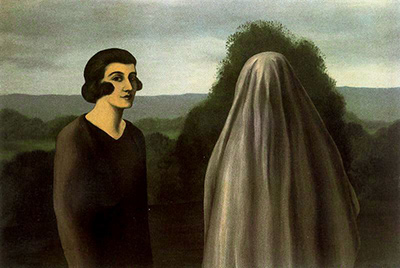The painting was created in 1928 and shows two ladies in an obscure landscape, with many shadows around. One of the women is covered by fabric and the other one stares at the viewer. The atmosphere of the artwork is misterious and at same time inspires melancholy and horror.
The Invention of Life is one of the several pieces of Rene Magritte that works the concepts of life and death. Still, the question that almost everyone asks while observing it is: "What does that mean?". This artwork has a typical element of Magritte's style: the feminine presence. Another interesting detail of The Invention of Life is the covered face. This feature is also found in the famous "The Lover II", where the faces of a woman and a man are hidden in cloth.
The Belgian artist Rene Magritte is an unforgettable name from the Surrealism movement. He admitted that his paintings evoke mistery, and in his opinion mistery means nothing. While the Invention of Life is composed with females, that's not the only common feature used by Magritte. Other paintings frequently had a man in bowler hat and a mixture of visual and textual elements.
Magritte had a unique ability to paint ordinary objects and people in way that viewers can't help but question what was behind, what was his intention with such pieces. This great artist had some of his works influenced by Andre Breton- the founder of Surrealism, Joan Miro - known for his minimalist and abstract artworks, and also by Salvador Dali - a master of the illusionistic Surrealism.
Despite being part of the Surrealism movement, Magritte preferred to keep his perfect strokes and follow his own illustrative style. Finally, a strong reference used by the artist was the psychotherapist Sigmund Freud, whose works motivated the artistic ideas about the ambiguity of objects and the blending of elements in a very unusual manner, without any logical sense, but just pure art.




